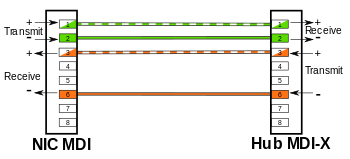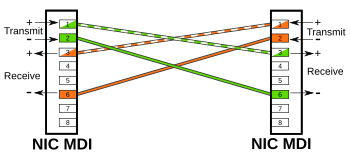Certains équipements modernes de réseau sont cependant capables de faire du MDI/MDI-X, c'est-à-dire du (dé)croisement automatique en fonction du type de câble utilisé, des adaptateurs réseaux et de la situation présente. Ce (dé)croisement se fait de manière logicielle au niveau d'un des deux adaptateurs (ou au sein du système d'exploitation) après que ceux-ci se sont mis d'accord sur l'adaptateur à inverser.
Lorsqu'on branche un poste de travail dans un
concentrateur (
hub) ou un
commutateur (
switch), un câble droit doit être utilisé. Lorsqu'on doit brancher deux postes de travail ensemble, un câble croisé doit être utilisé, sauf pour le cas d'une communication en gigabit où il faudra aussi utiliser un câble droit
MDI :
(Medium Dependent Interface port) Also called an "uplink port," it is a port on a network hub or switch used to connect to other hubs or switches without requiring a crossover cable
The MDI port does not cross the transmit and receive lines, which is done by the regular MDI-X ports that connect to end stations (the X stands for "crossed"). The MDI port connects to the MDI-X port on the other device. There are typically one or two ports on a device that can be toggled between MDI (not crossed) and MDI-X (crossed).
MDIX :
(
Medium
Dependent
Interface-crossed) A port on a network hub or switch that crosses the transmit lines coming in to the receive lines going out.
Since inputs on a NIC must go to outputs on the switch or hub these latter devices have their inputs and outputs (transmit and receive signals) reversed in a configuration known as
medium dependent interface crossover (
MDIX or MDI-X)
 |
| Straight-through MDI to MDI-X connection for 10BASE-T |
To connect two ports of the same configuration (MDI to MDI or MDIX to MDIX), an ethernet crossover cable was needed to cross over the transmit and receive signals in the cable pour se debarasser de ce prblm d avoir des port different et des cables differents on a :
Autosensing MDI/MDIX ports
make automatic modifications of the transmitting and receiving lines of the port so that they can both send and receive data between hub-connected
computers.
donc on pt utiliser un cable croisé ou droit pour les connecter
-
The connected Ethernet cable and the configuration of the opposite station's MDI/MDIX ports are automatically recognized and the port is configured so that all auto MDI/MDIX ports can be used as uplink ports. When data is transmitted from one computer to another it is first transmitted by the MDI port. The information is sent to a central hub or switch before moving on to be received by the MDI-X port of another computer.
-
The automatic line sensing in MDI ports detects whether a crossover is needed. This process eliminates the necessity of having separate MDI and MDI-X ports as well as switches and special crossover cables.
Automatic MDI/MDI-X
Gigabit Ethernet introduced automatic line sensing in the ports, which detects whether the crossover is needed or not. Referred to as "auto MDI/MDI-X," "universal cable recognition" and "auto sensing," it eliminates having separate MDI and MDI-X ports, selector switches and special crossover cables on the equipment
cette technologie de autosensing est implementé avec les gigabit ethernet pour les anciens :
 MDI/MDI-X Port
MDI/MDI-X Port
On hubs and switches that do not have auto MDI/MDI-X capability, one port typically provides the option of not crossing the lines. On this 10/100 switch, the MDI/MDI-X designations are represented with graphics that show the non-crossover and crossover configurations.
What is MDI and MDI-X?
Solution:
MDI and MDI-X are terms that define how RJ-45 (twisted pair) ports are wired. Traditionally, Network Interface Cards are configured as MDI ports. Networking devices, such as switches and hubs, are configured as MDI-X. Just as there are two types of port configurations, there are also two types of twisted pair networking cables: straight-through and crossover. When connecting similarly-pinned ports, such as MDI to MDI, or MDI-X to MDI-X, it is necessary to use a crossover cable.
When connecting MDI to MDI-X ports, a straight through cable is used.
DETAILS: MDI (Media Dependent Interface) ports receive signals on pins 1 and 2, and transmit signals on pins 3 and 6. The functions of these pin groupings are reversed on MDI-X (Media Dependent Interface Crossed) ports.
Straight-through cables are wired pin 1 to pin 1, pin 2 to pin 2; etc.. A straight through cable will connect the transmit elements of an MDI port to the receive elements in the MDI-X port, and vice versa.
If a straight-through cable is used to connect two ports with identical configurations (MDI to MDI, or MDI-X to MDI-X), the transmit elements in each port will be connected together, instead of to their corresponding receive elements. Because the receive elements would not receive any signals, neither port will exhibit a link, resulting in no data transfer between the ports. This is why it is historically necessary to use a crossover cable between similar port types.
Crossover cables link pin 1 to pin 3, and pin 2 to pin 6. A crossover cable will connect the transmit elements of an MDI-X port to the receive elements of another MDI-X interface, and MDI to MDI.
With the introduction of Auto MDI-X, however, the need to keep both crossover and straight-through cables on hand is somewhat mitigated. So long as a ProCurve Switch port is allowed to Autonegotiate, the switch will automatically sense the MDI/MDI-X state of a connecting port, and change the polarity accordingly.



Aucun commentaire:
Enregistrer un commentaire